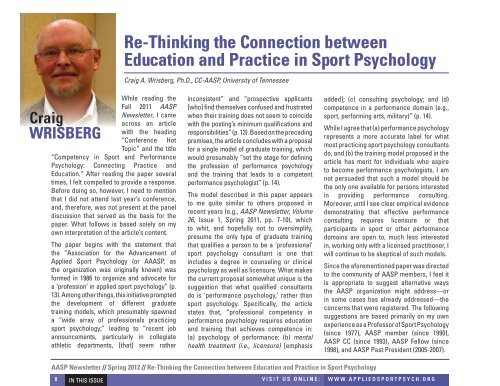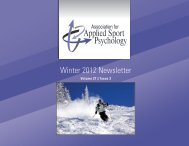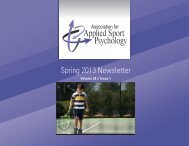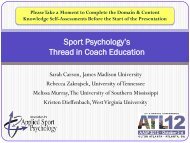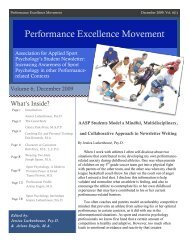Spring 2012 Newsletter - Association for Applied Sport Psychology
Spring 2012 Newsletter - Association for Applied Sport Psychology
Spring 2012 Newsletter - Association for Applied Sport Psychology
Create successful ePaper yourself
Turn your PDF publications into a flip-book with our unique Google optimized e-Paper software.
Re-Thinking the Connection between<br />
Education and Practice in <strong>Sport</strong> <strong>Psychology</strong><br />
Craig A. Wrisberg, Ph.D., CC-AASP, University of Tennessee<br />
Craig<br />
Wrisberg<br />
While reading the<br />
Fall 2011 AASP<br />
<strong>Newsletter</strong>, I came<br />
across an article<br />
with the heading<br />
“Conference Hot<br />
Topic” and the title<br />
“Competency in <strong>Sport</strong> and Per<strong>for</strong>mance<br />
<strong>Psychology</strong>: Connecting Practice and<br />
Education.” After reading the paper several<br />
times, I felt compelled to provide a response.<br />
Be<strong>for</strong>e doing so, however, I need to mention<br />
that I did not attend last year’s conference,<br />
and, there<strong>for</strong>e, was not present at the panel<br />
discussion that served as the basis <strong>for</strong> the<br />
paper. What follows is based solely on my<br />
own interpretation of the article’s content.<br />
The paper begins with the statement that<br />
the “<strong>Association</strong> <strong>for</strong> the Advancement of<br />
<strong>Applied</strong> <strong>Sport</strong> <strong>Psychology</strong> (or AAASP, as<br />
the organization was originally known) was<br />
<strong>for</strong>med in 1986 to organize and advocate <strong>for</strong><br />
a ‘profession’ in applied sport psychology” (p.<br />
13). Among other things, this initiative prompted<br />
the development of different graduate<br />
training models, which presumably spawned<br />
a “wide array of professionals practicing<br />
sport psychology;” leading to “recent job<br />
announcements, particularly in collegiate<br />
athletic departments, [that] seem rather<br />
inconsistent” and “prospective applicants<br />
[who] find themselves confused and frustrated<br />
when their training does not seem to coincide<br />
with the posting’s minimum qualifications and<br />
responsibilities” (p. 13). Based on the preceding<br />
premises, the article concludes with a proposal<br />
<strong>for</strong> a single model of graduate training, which<br />
would presumably “set the stage <strong>for</strong> defining<br />
the profession of per<strong>for</strong>mance psychology<br />
and the training that leads to a competent<br />
per<strong>for</strong>mance psychologist” (p. 14).<br />
The model described in this paper appears<br />
to me quite similar to others proposed in<br />
recent years (e.g., AASP <strong>Newsletter</strong>, Volume<br />
26, Issue 1, <strong>Spring</strong> 2011, pp. 7-10), which<br />
to whit, and hopefully not to oversimplify,<br />
presume the only type of graduate training<br />
that qualifies a person to be a ‘professional’<br />
sport psychology consultant is one that<br />
includes a degree in counseling or clinical<br />
psychology as well as licensure. What makes<br />
the current proposal somewhat unique is the<br />
suggestion that what qualified consultants<br />
do is ‘per<strong>for</strong>mance psychology,’ rather than<br />
sport psychology. Specifically, the article<br />
states that, “professional competency in<br />
per<strong>for</strong>mance psychology requires education<br />
and training that achieves competence in:<br />
(a) psychology of per<strong>for</strong>mance; (b) mental<br />
health treatment (i.e., licensure) [emphasis<br />
added]; (c) consulting psychology; and (d)<br />
competence in a per<strong>for</strong>mance domain (e.g.,<br />
sport, per<strong>for</strong>ming arts, military)” (p. 14).<br />
While I agree that (a) per<strong>for</strong>mance psychology<br />
represents a more accurate label <strong>for</strong> what<br />
most practicing sport psychology consultants<br />
do, and (b) the training model proposed in the<br />
article has merit <strong>for</strong> individuals who aspire<br />
to become per<strong>for</strong>mance psychologists, I am<br />
not persuaded that such a model should be<br />
the only one available <strong>for</strong> persons interested<br />
in providing per<strong>for</strong>mance consulting.<br />
Moreover, until I see clear empirical evidence<br />
demonstrating that effective per<strong>for</strong>mance<br />
consulting requires licensure or that<br />
participants in sport or other per<strong>for</strong>mance<br />
domains are open to, much less interested<br />
in, working only with a licensed practitioner, I<br />
will continue to be skeptical of such models.<br />
Since the a<strong>for</strong>ementioned paper was directed<br />
to the community of AASP members, I feel it<br />
is appropriate to suggest alternative ways<br />
the AASP organization might address—or<br />
in some cases has already addressed—the<br />
concerns that were registered. The following<br />
suggestions are based primarily on my own<br />
experience as a Professor of <strong>Sport</strong> <strong>Psychology</strong><br />
(since 1977), AASP member (since 1990),<br />
AASP CC (since 1993), AASP Fellow (since<br />
1998), and AASP Past President (2005-2007).<br />
AASP <strong>Newsletter</strong> // <strong>Spring</strong> <strong>2012</strong> // Re-Thinking the Connection between Education and Practice in <strong>Sport</strong> <strong>Psychology</strong><br />
8 In This Issue<br />
Visit us Online:<br />
www.appliedsportpsych.org


